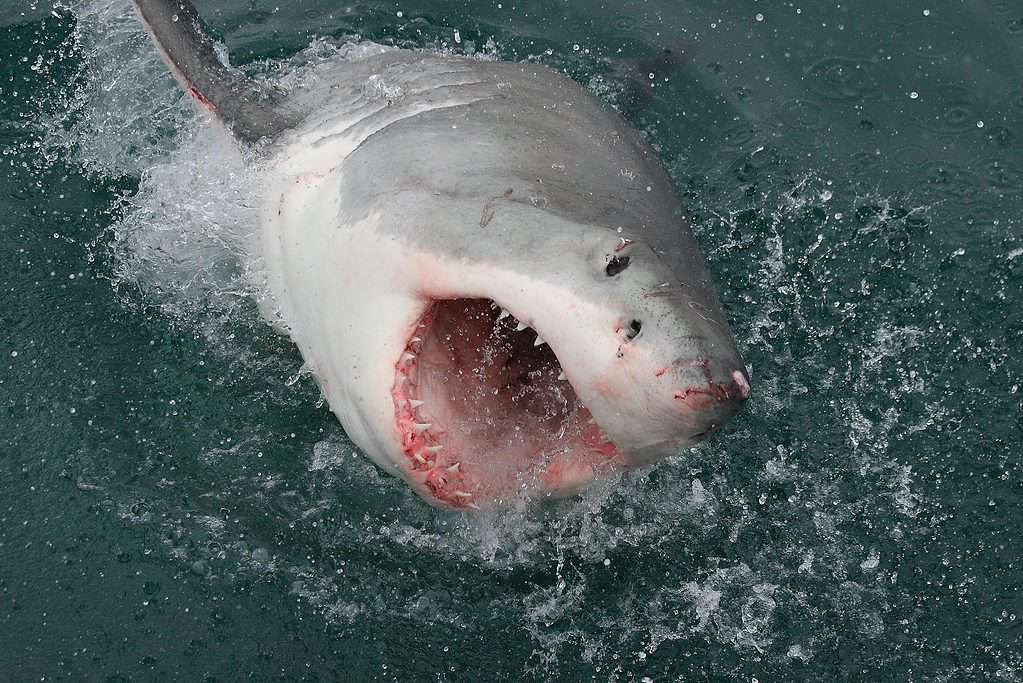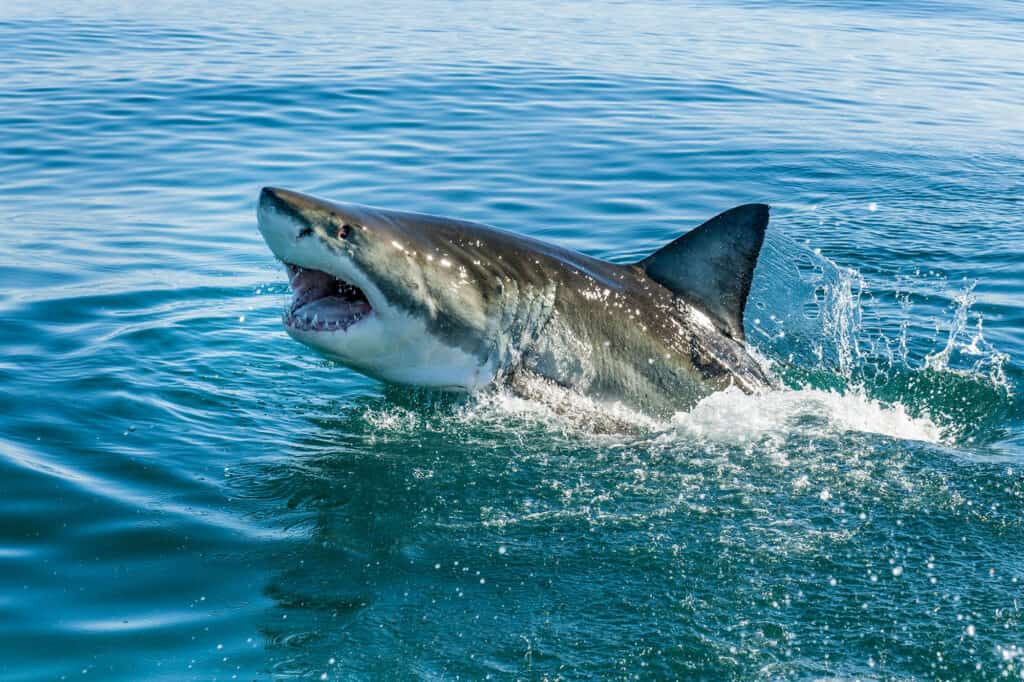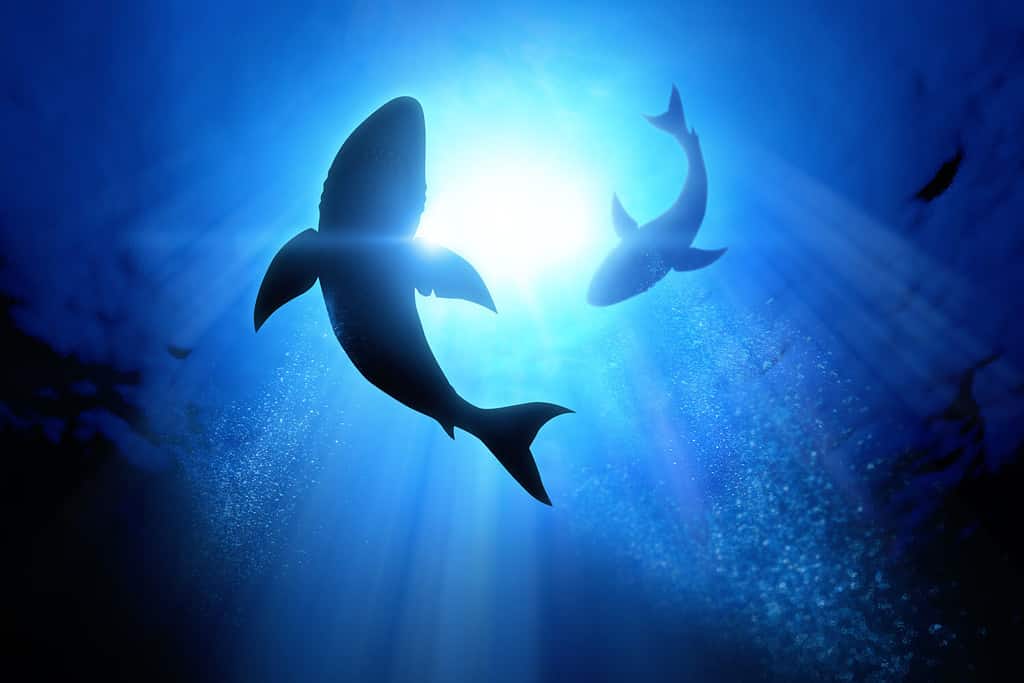Sharks are not warm and cuddly like cats or dogs. They are filled with interesting surprises that many people have never even considered. It’s tough to picture an adorable infant great white shark, but they are quite cute! Did you know that the great white shark’s speed of growth, when growth spurts have occurred, and what type they have been can all be determined by its growth rings? These are similar to those on the inside of a tree, which also states its approximate age and health. Let’s find out what those growth rings are and what they tell about the impressive great white shark.
Fierce Hunters of the Sea: The Great White Shark (Carcharodon carcharias)

Great white sharks are the most feared species of shark, though they are not as dangerous as the media would like you to believe.
©Alessandro De Maddalena/Shutterstock.com
Appearance: Great white sharks are dark brown, blue-grey, or dark grey on their upper and white on their undersides. They are torpedo-shaped sharks with sharply pointed noses, large pectoral and dorsal fins, and a large crescent-shaped tail fin. Their teeth are large and serrated. The sharks have a very good sense of smell and excellent eyesight. Unlike most fish, the white shark is a form of warm-blooded called regional endothermy, which helps them stay warm in very cold water.
Size: They are four feet long at birth and can grow to 21 feet long as an adult. The shark’s adult weight is 1,500 – 6,000 pounds.
Habitat: Though their habitats change as they age, they can be found near the coast in temperate waters for abundant feeding and, occasionally, in the open ocean. Juvenile great whites spend years in estuaries like those found off the California coast. They have a long migration every year, with South African great whites migrating to Australian waters and California great whites migrating to the Hawaiian Islands. Migrations of several thousands of miles are standard for solitary sharks.
Lifespan: They live 40 – 70 years, though it is not fully understood how long they can live to be. Males mature around 26 years old, and females do so at nearly 33 years of age.
What are the Growth Rings of a Great White Shark?

A shark’s vertebral bands, or growth rings, show the shark’s growth rate, similar to that of a tree.
©Jambura PL, Kriwet J / CC BY 4.0 – License
Growth rings are found on the inside of tree trunks. They can show times of growth due to a thriving ecosystem and the tree’s health. They can also show when there has been a drought, flooding, or other severe weather events that may have caused stress to the tree’s health. Tree rings are fairly evenly spaced apart, and though they cannot be seen until the tree is cut down, exposing the core, they have offered valuable insight into the long life of the tree. It’s a bit like reading the tree’s diary.
Sharks are similar to trees when it comes to growth rings. The shark’s growth rings are made of tissue on the inside of their vertebral column. All sharks have these varying darker and lighter opaque rings. In the great white shark, the light and dark rings are narrow and blur together, creating confusion over whether or not the rings are laid down annually, like with some of the smaller sharks, or if they symbolize growth in the length of the growing shark.
Many types of smaller sharks seem to follow the tree’s annual rings, but the great white shark’s growth rings are evenly spaced apart until they hit maturity. From that point forward, the growth rings are more spaced out and may symbolize growth in the girth of the shark but not length. Scientists believe that as a shark lengthens, the growth rings are evenly spaced. Once the shark begins to gain girth, it throws off the equal spacing and becomes wider in between each ring, suggesting a slow-growing girth, which is what has been discovered in the great white shark’s vertebral column.
What Can We Learn From a Great White Shark’s Growth Rings

The great white shark has been stumping scientists for many decades.
©iStock.com/ELizabethHoffmann
Scientists began with information on the widely varied lifespan of the great white sharks. After this, they took into consideration when the males and females reached maturity. For the females, it was 33 years, whereas the males reached it at 26 years of age. By studying deceased great white sharks’ growth through close inspection and imaging of the vertebrae, researchers can uncover that the great white shark is indeed a slow grower.
This information came as a surprise when compared to the growth of other species of sharks. The great white shark has a longer lifespan than some of the other sharks. Scientists are trying to figure out if any environmental factors are playing a part in the slow growth of the great whites. Since the vertebrae can only be studied on deceased sharks, it creates a barrier in the research and has proven to be unsuccessful in deciphering the age of the sharks with each ring.
Sharks that Stump Scientists
Great white sharks are a protected species, and it is illegal to harm one, even in the name of science. Without being able to look at the vertebrae rings throughout the shark’s life to put the puzzle pieces together has left scientists stumped. Little else can be done to synthetically replicate what happens to a great white shark as they grow. It is also hard to say if every great white grows at the same pace. Perhaps the temperature of the water in the estuary has something to do with it.
Though, it does not currently help solve the question of whether a great white shark’s age can be decoded by viewing the growth rings on their vertebrae, the tagging of great white sharks will pay off in time. Following the sharks’ lives can help scientists unravel the question of how the sharks age and at what points in their lives they hit growth spurts. Since the great white sharks live from 25 years to anywhere near 100, it can be a long wait to find out the answers.
Interesting Facts About the Great White Shark

It is not known if the great white shark lives past 70 years old, but some think that they do.
©solarseven/Shutterstock.com
- The infamous great white shark is the largest predatory shark out of 450!
- A great white’s teeth can reach 6.6 inches long.
- The only area of water that the great white shark does not live in is that of Antarctica.
- Great white sharks are solitary animals, but pairs have been spotted traveling together.
- They can smell a drop of blood in the water from over three miles away!
- Great white sharks do not like the taste of humans and have been reported spitting humans out. Almost every attack has been one of mistaken identity or because the shark was provoked.
- They can sense a millionth of a volt in the water, which helps them find prey. This advantage is called electroception.
- A great white’s blood is packed full of mercury and arsenic, which makes it toxic to almost all animals.
- Since they are highly adapted to hunt during the night, the shark’s eyes reflect light. This is similar to the glow of a cat’s eyes.
- Great white sharks have been around longer than the dinosaurs at 400 million years old.
- The sharks can open their mouth eight feet wide.
- There is a hierarchy of dominance among great white sharks with the females being larger and more dominant.
The photo featured at the top of this post is © iStock.com/Martin Heyn
Thank you for reading! Have some feedback for us? Contact the AZ Animals editorial team.







